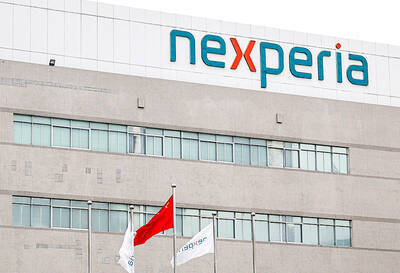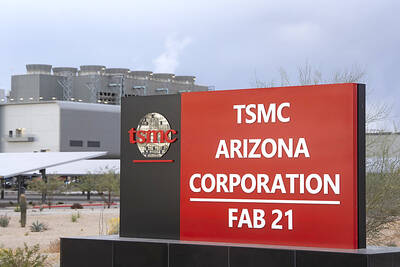Taiwan is proving a magnet for overseas academic and trade delegations looking to learn more about the nation's burgeoning nanotechnology industry, an official from the nation's top nanotech research center said yesterday.
"Many overseas delegations are visiting us to understand Taiwan's position in the nanotechnology industry," Tsai Pin-pin (
Nanotechnology involves the manipulation of atoms and molecules on the scale of the nanometer -- one-billionth of a meter.
Some theoretical applications of the technology are the creation of tiny robots that can hunt down and destroy cancer cells, or new computer storage devices that reduce corporate storage disks to the size of a postage stamp.
But the scale of nanotech research needs international cooperation, one expert said.
"To do good science these days, it takes a multi-disciplinary team, especially in nano-science," said Karan Kaler, director of the Calgary Institute of Nanotechnology in western Canada.
Kaler is part of a 21-member nanotech delegation brought to Taiwan by Canada's Department of Foreign Affairs and International Trade.
The fact-finding mission to Japan, South Korea and Taiwan aims to develop partnerships between Canadian academics and Asian researchers to accelerate developments in nanotechy, Dave Murphy, trade and investment director at the Canadian Trade Office in Taipei said.
"Ultimately, the objective is to develop projects and relationships that can derive economic and social benefits," Murphy said. "We're looking at [nanotech] in a practical and pragmatic way, and that's establishing a better understanding of the programs and activities that are underway on both sides."
For four days the delegation is meeting with nanotech experts from the National Science Council, ITRI, National Tsing-hua University and National Chiao-tung University. Professors from different fields of nanotech are giving presentations on the developments in their specific fields of research to find out if local researchers are interested, or able, to cooperate in their research. The delegation will travel to South Korea tomorrow and return to Canada on Saturday.
Hamid Mostaghaci, the leader of the delegation, estimates that the nanotech industry will be worth US$1 trillion within 20 years. The Canadian government has already provided C$120 million (US$81 million) to the Canadian National Institute for Nanotechnology in Edmonton, C$110 million (US$74 million) in NanoQuebec, which is an initiative linking industry and academia in the Province of Quebec, and C$200 million (US$135 million) in the Canadian Fund for Innovation, a fund awarded to nanotech researchers.
Some delegations may be headhunting in Taiwan. Professor Federico Rosei of the Institut National de la Recherche Scientifique at the University of Quebec is looking for 11 new nanotech professors to work in his labs next year.
Taiwan's National Science Council and the Canadian National Research Council have a collaborative nanotech-research program, Murphy said. Small delegations have visited Canada as part of this collaboration over the past six years.
But the nano-science community needs to keep the public informed "of the potential for what is good and not so good in the nano-sciences," said Robert Sing, administrative director of NanoQuebec.
The "gray goo" theory, popularized in Michael Crichton's novel Prey, where nano-robots turn all matter on the planet to mush, has already begun to alarm the public.

JITTERS: Nexperia has a 20 percent market share for chips powering simpler features such as window controls, and changing supply chains could take years European carmakers are looking into ways to scratch components made with parts from China, spooked by deepening geopolitical spats playing out through chipmaker Nexperia BV and Beijing’s export controls on rare earths. To protect operations from trade ructions, several automakers are pushing major suppliers to find permanent alternatives to Chinese semiconductors, people familiar with the matter said. The industry is considering broader changes to its supply chain to adapt to shifting geopolitics, Europe’s main suppliers lobby CLEPA head Matthias Zink said. “We had some indications already — questions like: ‘How can you supply me without this dependency on China?’” Zink, who also

Taiwan Semiconductor Manufacturing Co (TSMC, 台積電) received about NT$147 billion (US$4.71 billion) in subsidies from the US, Japanese, German and Chinese governments over the past two years for its global expansion. Financial data compiled by the world’s largest contract chipmaker showed the company secured NT$4.77 billion in subsidies from the governments in the third quarter, bringing the total for the first three quarters of the year to about NT$71.9 billion. Along with the NT$75.16 billion in financial aid TSMC received last year, the chipmaker obtained NT$147 billion in subsidies in almost two years, the data showed. The subsidies received by its subsidiaries —

At least US$50 million for the freedom of an Emirati sheikh: That is the king’s ransom paid two weeks ago to militants linked to al-Qaeda who are pushing to topple the Malian government and impose Islamic law. Alongside a crippling fuel blockade, the Group for the Support of Islam and Muslims (JNIM) has made kidnapping wealthy foreigners for a ransom a pillar of its strategy of “economic jihad.” Its goal: Oust the junta, which has struggled to contain Mali’s decade-long insurgency since taking power following back-to-back coups in 2020 and 2021, by scaring away investors and paralyzing the west African country’s economy.

RE100 INITIATIVE: Exporters need sufficient supplies of renewable energy to meet their global commitments and remain competitive, the economics ministry said Local export-oriented manufacturers, including Taiwan Semiconductor Manufacturing Co (台積電), require sufficient supplies of green energy to maintain their competitiveness and regulations already ensure that renewable energy development adheres to environmental protection principles, the Ministry of Economic Affairs said yesterday, as the legislature imposed further restrictions on solar panel installations. The opposition-led Legislative Yuan yesterday passed third readings to proposed amendments to three acts — the Environmental Impact Assessment Act (環境影響評估法), the Act for the Development of Tourism (發展觀光條例) and the Geology Act (地質法) — which would largely prohibit the construction of solar panels in some areas. The amendments stipulate that ground-mounted solar